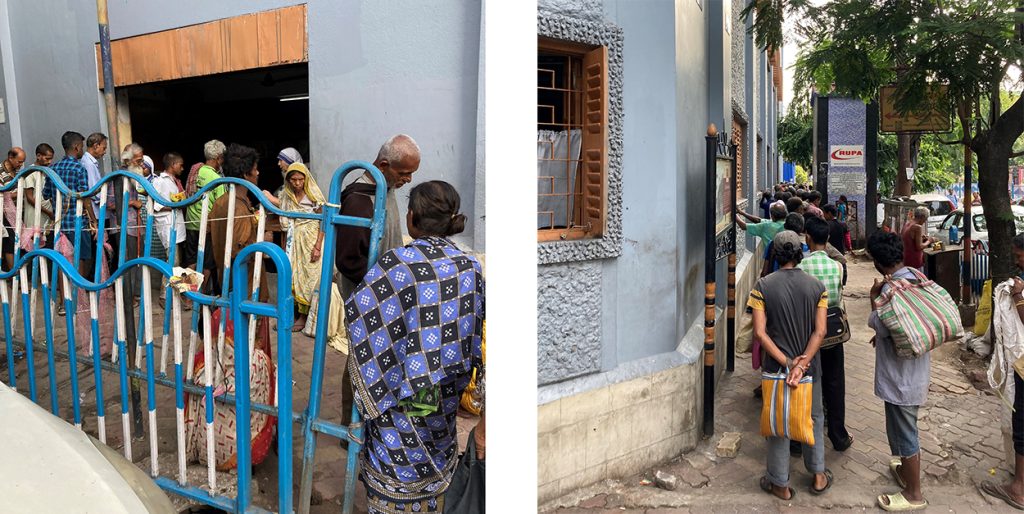A Tale of Two Cities
Calcutta then and now
May 30th, 2024May 30, 2024
By Jim Towey
I had much to think about this week as I returned from my 21st trip to Calcutta. So much has changed there. So much hasn’t.
Many historians believe the city, once known as Kalikata, received its name in the late 17th century when Job Charnock, a British merchant of the East India Company, first settled along the east bank of the Hooghly River near a shrine named in honor of Kali, the Hindu goddess. A century and a half later, not far from that site, the massive Kali temple was built for devotees to worship Kali, offer sacrifice, and cremate their kin. Its location along a tributary that flowed into the Ganges River (which Hindus hold sacred) made it an ideal place of pilgrimage, as well as destination for the dead.
Pure of heart
It was on these same grounds that Mother Teresa improbably founded the most important Christian mission of the 20th century. She named it, “Nirmal Hriday,” (which means “place of the pure of heart”), although most people, then and now, refer to it as Kalighat because of its connection to the Hindu temple and its funereal rites.
Mother Teresa and the goddess Kali provide two strikingly contrasting portraits of motherhood. The tiny, humble woman clad in a white cotton sari pinned with a small crucifix stands in stark contrast to the dark Hindu deity of death, destruction, and purification traditionally depicted as a dark-skinned mother wearing a necklace of skulls, with her tongue sticking out, and brandishing a knife in one of her many hands. And yet, today the two feminine icons are oddly paired by history. Both in their own way put Calcutta on the map.
Before Mother Teresa opened her mission at Kalighat, the building had been a guest house for wayfarers who journeyed from afar, but over time, it became overrun by thugs and gamblers who threatened the safe passage of pilgrims. In 1952, the local governmental authority, the Calcutta Corporation, offered the use of Kalighat to the nun in order to evict the criminal element, and also get her off their backs. For some time, she had made repeated entreaties to them for a suitable space where, free of charge, she could care for the gravely ill whom area hospitals had forsaken. It was at this sacred site, for 45 years, that Mother Teresa and her followers cared for tens of thousands of the area’s dying destitute, and in the process, made Kalighat famous.
Back in Calcutta
I was there last week. The configuration of the cots – 50 for men on the side nearest the entrance and 50 for women on the other side – had not changed. Neither had the compassion of the sisters who ministered to the gravely ill. The patients, too, looked the same as the dying I first encountered there in 1985.

I got the sense that time had stood still at Kalighat. The internet and technological revolution that has transformed modern life outside the premises has left everything inside untouched. The dignity of the poor and the loving care provided by the women following in Mother Teresa’s footsteps have marched through these decades with timeless grace, as lovely as ever. The place is a haven for more than the dying. It felt good to be standing again on those sacred grounds.
An up-and-coming city
The city itself has seen drastic improvement in every aspect of life. Foreign investment began pouring into the area beginning in 2011 when the ruling communist party was ousted after 34 years of uninterrupted rule, and it has left its mark. This new prosperity is an echo of an earlier era when Calcutta was India’s capital until 1911. Now “the city of dreadful night,” as Rudyard Kipling described it, is slowly shedding its reputation for being synonymous with urban destitution and quickly becoming a viable economic presence on the sub-continent. Four- and five-star hotels are springing up throughout the area, bypass highways are being built to accommodate the relentless traffic, and a stock of middle-class housing is steadily emerging. However, millions of people still live at the subsistence level. The slums where Mother Teresa first walked 75 years ago have changed very little. The six main facilities the Missionaries of Charity operate in this city of nearly 16 million continue to house thousands of the worst cases, and the food they distribute daily sustains multiples more.
An election is underway in India, the world’s largest democracy, and it appears likely that Narendra Modi, the incumbent prime minister and Hindu nationalist with giant-sized aspirations, will get another five-year term.
What will that mean for the slum dwellers? I suspect more of the same misery. In Modi’s world, they seem virtually invisible. But in the world of Mother Teresa’s nuns, they are everything.
(The opinions expressed herein are those of the author and do not necessarily reflect the views of Aging with Dignity and/or its Board of Directors.)
Share



